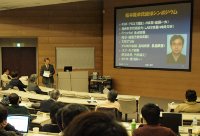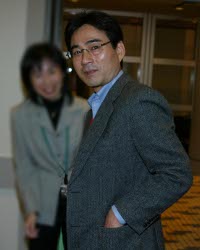 |
 |
|||||||||||||
|
|||||||||||||
|
|||||||||||||
|
The 4th annual ILC detector workshop was held at KEK from 2 to 4 December. This series of workshops, led by Hitoshi Yamamoto, professor at Tohoku University, are funded by the Creative Scientific Research Program of the Japan Society for the Promotion of Science. This workshop marked the first after the validation of ILC detectors by the International Detector Advisory Group, and scientists discussed the global efforts toward the 'detailed baseline design' of ILC detector. One afternoon of this workshop was spent as a tribute to the memory of Takayuki Matsui, a professor at KEK who passed away last April devoting his life to build a strong foundation to realise the linear collider. Matsui started working on the linear collider project in 1980s, when the project was called JLC – the post-Tristan high-energy physics programme that was recommended by the Japanese High Energy Physics Committee in 1986. Japanese scientists wrote up the JLC-1 report in 1992, which aimed to identify important physics targets and clarify required machine and detector parameters. “Matsui was the core figure to getting Japanese physics and detector community together,” said Sachio Komamiya, professor at the University of Tokyo. “When the scientists lead by late Professor Orito wrote that report, they thoroughly went over all the possible physics scenarios. This report is still our Bible,” he added. Matsui also made huge contribution to the establishment of the Worldwide Study of the Physics and Detectors for Future Linear Colliders (WWS) in 1998. Until the research directorate effectively took over, the WWS played a key role in organising the global efforts on physics and detectors for the linear collider, coordinating the work in the three regions — Europe, North America and Asia. Since the concept of the detector won't depend on the detailed accelerator design, the physics and detector community had already started working in collaboration between three regions ahead of the accelerator activities. “Matsui was committed to bring Asian effort together, and managed to do so,” said Komamiya. In 1995, the 3rd Linear Collider Workshop was held for the first time in Japan, at Appi Highland. Matsui was the key person in the local organising committee who brought this meeting to a success, visiting the conference venue numerous times. “He took care of almost everything. He even designed the poster. I think he believed that it is the quickest way to realise the linear collider was to take small step after step,” said Seishi Takeda, the Director of the Japan Society for the Promotion of Science, San Francisco Office. “After the success of the first conference, he started another APPI meeting – the Accelerator and Particle Physics Institute – at Appi.” APPI was a small international conference with around 30 scientists in the friendly setting of a ski resort, discussing numerous topics with theorists, experimentalists, and accelerator scientists. “His ambition was to turn the A for Appi to A for Asia. He really worked hard to bring the Asian community together.” Matsui's health condition deteriorated around 2003, and he left the centre stage of the linear collider R&D then. Takeda visited Matsui's parents' house this summer to pray. His mother said to him that Matsui was talking about something she did not understand until his last moment. “I am sure that what he was talking about was the linear collider. That was his lifework. We shall strive to realise the ILC,” Takeda said. Matsui's passion for the linear collider remains and continues in many Japanese scientists' hearts. -- Rika Takahashi |
|||||||||||||
| © International Linear Collider |

